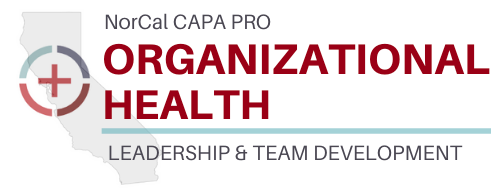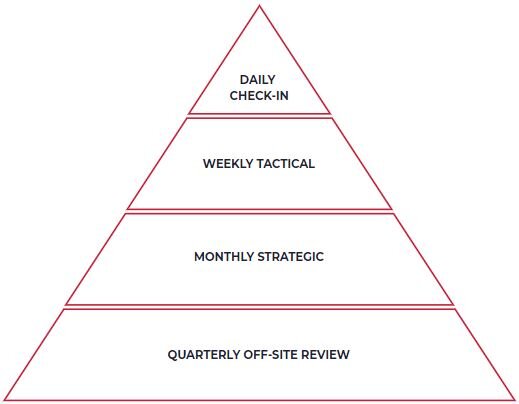
Changing the World of Work
Building a Healthy Organization
In Patrick Lencioni’s best-selling book, The Advantage: Why Organizational Health Trumps Everything Else in Business, he makes an overwhelming case that organizational health will surpass all other disciplines in business as the greatest opportunity for improvement and competitive advantage. Drawing on his extensive consulting experience and reaffirming many of the themes cultivated in his other best-selling books, he reveals the four actionable steps to achieving long-term, sustainable success.
Four Disciplines of Organizational Health
What exactly does an organization have to do to get healthy? There are four simple but challenging steps.
Discipline 1: Build a cohesive leadership team.
Master the behaviors outlined in The Five Dysfunctions of a Team
Take a Team Assessment
Learn about your personality (MTBI, DISC, etc.)
Understand your Working Genius
Discipline 2: Create Clarity
Complete the Six Critical Questions Worksheet
Discipline 3: Overcommunicate Clarity
Importance of Communication
Use our Meetings Model and Meeting Summary Worksheet
Discipline 4: Reinforce Clarity
Ideal Team Player tools for hiring, development and leading.
Improve Employee Engagement
Discipline 1: Build a Cohesive Team
The first and most critical step in a healthy organization is creating a cohesive leadership team that is committed to do the ongoing work of developing and maintaining a high-performing team and mastering the five behaviors outlined in The Five Dysfunctions of a Team.
The Five Dysfunctions Model and Summary
Like it or not, all teams are potentially dysfunctional. This is inevitable because they are made up of fallible, imperfect human beings. However, facing dysfunction and focusing on teamwork is particularly critical at the top of an organization because the executive team sets the tone for how all employees work with one another. The first step toward reducing politics and confusion within your team is to understand that there are five dysfunctions to contend with, and address each that applies, one by one.
DYSFUNCTION #1: ABSENCE OF TRUST
The fear of being vulnerable prevents team members from building trust with each other.
DYSFUNCTION #2: FEAR OF CONFLICT
The desire to preserve artificial harmony stifles productive ideological conflict within the team.
DYSFUNCTION #3: LACK OF COMMITMENT
The lack of clarity and/or buy-in prevents team members from making decisions they stick to.
DYSFUNCTION #4: AVOIDANCE OF ACCOUNTABILITY
The need to avoid interpersonal discomfort prevents team members from holding each other accountable for their behaviors and performance.
DYSFUNCTION #5: INATTENTION TO RESULTS
The pursuit of individual goals and personal status erodes the team's focus on collective success.
Team Assessment Report
Based on the best-selling book The Five Dysfunctions of a Team, the Online Team Assessment is the great tool for leaders and managers looking to make their teams more cohesive and effective. Used by nearly half of a million people, no single product has helped transform the landscape of teamwork and change the world of work more. This is the perfect starting place for anyone looking to overcome team dysfunction and realize their potential.
Simplicity is the key. Building a healthy team is not complicated, but it takes discipline and focus. With only 42 questions and a custom color-coded report, the Online Team Assessment provides teams with practical, usable data that will help address their most critical issues and begin to make tangible progress right away.
The Online Team Assessment is the fastest way to build a more cohesive team, so join the thousands of others in making your team more effective.
The 6 Types of Working Genius
By using The Six Types of Working Genius assessment, a team can identify, discuss and address serious individual and collective problems in less than three hours. Individual team members can increase their productivity and morale by maximizing the time they spend in their areas of genius and minimizing the time they spend in their areas of frustration. A team can significantly increase the likelihood of success by ensuring that they have filled all six of the geniuses required to get something done.
THE GENIUS OF WONDER
The natural gift of pondering the possibility of greater potential and opportunity in a given situation. (video)
THE GENIUS OF INVENTION
The natural gift of creating original and novel ideas and solutions. (video)
THE GENIUS OF DISCERNMENT
The natural gift of intuitively and instinctively evaluating ideas and situations. (video)
THE GENIUS OF GALVANIZING
The natural gift of rallying, inspiring and organizing others to take action. (video)
THE GENIUS OF ENABLEMENT
The natural gift of providing encouragement and assistance for an idea or project. (video)
THE GENIUS OF TENACITY
The natural gift of pushing projects or tasks to completion to achieve results. (video)
Discipline 2: Create Clarity
Creating clarity at the executive level is essential to building and maintaining a healthy organization. There are six simple but critical questions that need to be answered, eliminating all discrepancies among team members.
Answer the Six Critical Questions
The second requirement for building a healthy organization is all about achieving alignment. A playbook provides a repository of information outlining an organization’s clarity. Clarity is initially established by answering the six critical questions in a concise, actionable way, so that they can be used in decision making, communication and planning.
Establish a Thematic Goal / Rallying Cry
A thematic goal provides a rallying cry for an organization–a clear direction for the entire organization for a fixed period of time determined by answering the question, “What is most important right now?”
Identify specific shared Defining and Operating Objectives that must take place to help achieve the Thematic goals.
Defining Objectives are qualitative components that serve to clarify exactly what is meant by the thematic goal; shared by all members of the team. Defining objectives provide a level of specificity so that the thematic goal isn’t merely a slogan but rather a specific and understandable call to action.
Standard Objectives are the ongoing and relatively straightforward metrics and areas of responsibility that any leadership team must maintain to keep the organization afloat. These objectives do not go away from period to period and often include topics such as revenue, expenses, customer satisfaction, quality, etc.
The image on the left is a sample completed by a tire manufacturing company.
Discipline 3: Overcommunicate Clarity
Once a leadership team has become cohesive and established clarity around the six critical questions, they need to communicate the answers to employees over and over again. There are specific communication strategies the leadership team can employ to ensure that messaging is consistent and absorbed by employees.
Meetings Model
It is possible to transform tedious and debilitating meetings into productive, focused, and even energizing. The key to improving meetings has little to do with better preparation, agendas or minutes. Attendees need to understand the importance of the meeting, know the context and purpose, as well as be willing to engage in conflict about important issues being discussed.
DAILY CHECK IN
Connect informally around any relevant administrative items.
Share daily schedules and activities.
WEEKLY TACTICAL
Review weekly activities and metrics, and resolve tactical obstacles and issues.
MONTHLY STRATEGIC
Discuss, analyze, brainstorm and decide upon critical issues affecting long term success.
QUARTERLY OFF-SITE REVIEW
Review strategy, competitive landscape, industry trends, key personnel, and team development.
Weekly Tactical Meeting Guide
Follow this guide to have more effective weekly tactical meetings.
Lightning Round (5-10 min): Have each team member list top three things they are working on in the coming week. This should take about 1 minute each
Scoreboard Review (5 min): Review the Thematic Goal and objectives, note the current status in Green, Yellow or Red.
Tactical Agenda Items (30 min): Discuss the issues to be covered, assign order for discussion and begin. These are issues that came up in the lightning round or scoreboard review.
Potential Strategic Topics: List strategic topics that come up and need to be covered in-depth during a separate meeting. To not try and resolve these during the tactical meeting.
Decisions/Actions (5 min): Have one team member keep track of decisions and actions that were committed to.
Cascading Messages (5 min): Discuss what each team member should communicate to their direct reports after the meeting. Agree on a timeframe for that messaging to occur.
Discipline 4: Re-enforce Clarity
For an organization to be healthy, organizational clarity (the six critical questions) must become embedded into the fabric of the organization. Systems in the following areas need to tie to the six questions: Recruiting and hiring, managing performance, compensation and rewards and real-time recognition
The Ideal Team Player Model and Summary
Some people are better at teamwork than others. These are the kind of people who add immediate value in a team environment and require much less coaching and management to contribute in a meaningful way. What do these people look like? And how do we find them? As it turns out, they have three qualities or virtues in common: they are humble, hungry and smart.
HUMBLE
Ideal team players are humble. They lack excessive ego or concerns about status. They are quick to point out the contributions of others and slow to seek recognition for their own. They share credit, emphasize team over self, and define success collectively rather than individually.
HUNGRY
Ideal team players are hungry. They are always looking for more—more things to do, more to learn, more responsibility. Hungry people rarely have to be pushed by a manager to work harder because they are self-motivated and diligent. They are constantly thinking about the next step and the next opportunity.
SMART
Ideal team players are smart. They are emotionally intelligent and have common sense about people. They tend to know what is happening in a group situation and how to effectively deal with others. They have good judgment and intuition around the subtleties of group dynamics and the impact of their words and actions.
With enough time, patience and attention from a good manager, almost anyone can learn to become a team player.
Employee Engagement Model and Summary
Having a good job or a bad job is entirely subjective and may depend on many factors: pay, prestige, security, schedule, etc. What is not subjective is the definition of a miserable job. People who are miserable in their jobs dread going to work and come home frustrated, defeated and weary. . Some studies show as high as 77% of workers are dissatisfied with their work, and that the primary driver of job dissatisfaction is not pay or benefits, but rather the relationship that an employee has with his or her supervisor. There are three areas managers needs to consider and address with each employee.
ANONYMITY
People cannot be fulfilled in their work if they do not feel known. All human beings need to be understood and appreciated for their unique qualities by someone in a position of authority.
IRRELEVANCE
Everyone needs to know that their job matters to someone—anyone. Without seeing a connection between their work and the satisfaction of other people, an employee will not find lasting fulfillment.
IMMEASUREMENT
Employees need to be able to gauge their own progress and level of contribution. People cannot be fulfilled in their work if their success depends entirely on the opinions or whims of another person.
The materials, models and content on this page were created by Patrick Lencioni and The Table Group. They are used with permission.










